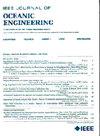MLMFFNet:用于实时前视声纳图像分割的多级混合特征融合网络
IF 5.3
2区 工程技术
Q1 ENGINEERING, CIVIL
引用次数: 0
摘要
前视声纳是水下目标探测的重要工具,而图像分割是前视声纳图像处理的重要组成部分。声纳图像的精确分割是至关重要的,但水下环境的复杂性带来了挑战,如低分辨率、明显的噪声和模糊的目标边缘。这些因素使得实时、精确的分割变得尤为困难。为了解决这些挑战,我们提出了一种新的实时分割网络,即多级混合特征融合网络(MLMFFNet),专门为前视声纳图像设计。我们的方法利用独特的MFF模块和多尺度MFF模块,使用深度卷积网络、扩展卷积和部分卷积组合提取局部和上下文信息,以实现有效的信息集成。此外,我们还结合了上下文连接模块,通过利用高级上下文信息来增强特征融合。为了进一步提高准确性,我们引入了三个加权损失函数,旨在解决不平衡的样本分布和模糊的边界。对两种不同的前视声纳数据集的实验评估表明,MLMFFNet显著优于许多最先进的通用和声纳特定语义分割网络,在保持实时性能的同时提供卓越的分割精度。本文章由计算机程序翻译,如有差异,请以英文原文为准。
MLMFFNet: Multilevel Mixed Feature Fusion Network for Real-Time Forward-Looking Sonar Image Segmentation
Forward-looking sonar is a critical tool for underwater target detection, and segmentation is an essential component of forward-looking sonar image processing. Accurate segmentation of sonar images is vital, but the complexity of the underwater environment introduces challenges, such as low resolution, significant noise, and blurred target edges. These factors make real-time, precise segmentation particularly difficult. To address these challenges, we propose a novel real-time segmentation network, the multilevel mixed feature fusion network (MLMFFNet), specifically designed for forward-looking sonar images. Our approach leverages a unique MFF module and a multiscale MFF module to extract both local and contextual information using deep convolutional networks, dilated convolutions, and partial convolution combinations for effective information integration. Additionally, we incorporate a context connection module to enhance feature fusion by utilizing high-level contextual information. To further improve accuracy, we introduce three weighted loss functions designed to address imbalanced sample distributions and blurred boundaries. Experimental evaluations on two distinct forward-looking sonar data sets demonstrate that MLMFFNet significantly outperforms many state-of-the-art general and sonar-specific semantic segmentation networks, delivering superior segmentation accuracy while maintaining real-time performance.
求助全文
通过发布文献求助,成功后即可免费获取论文全文。
去求助
来源期刊

IEEE Journal of Oceanic Engineering
工程技术-工程:大洋
CiteScore
9.60
自引率
12.20%
发文量
86
审稿时长
12 months
期刊介绍:
The IEEE Journal of Oceanic Engineering (ISSN 0364-9059) is the online-only quarterly publication of the IEEE Oceanic Engineering Society (IEEE OES). The scope of the Journal is the field of interest of the IEEE OES, which encompasses all aspects of science, engineering, and technology that address research, development, and operations pertaining to all bodies of water. This includes the creation of new capabilities and technologies from concept design through prototypes, testing, and operational systems to sense, explore, understand, develop, use, and responsibly manage natural resources.
 求助内容:
求助内容: 应助结果提醒方式:
应助结果提醒方式:


